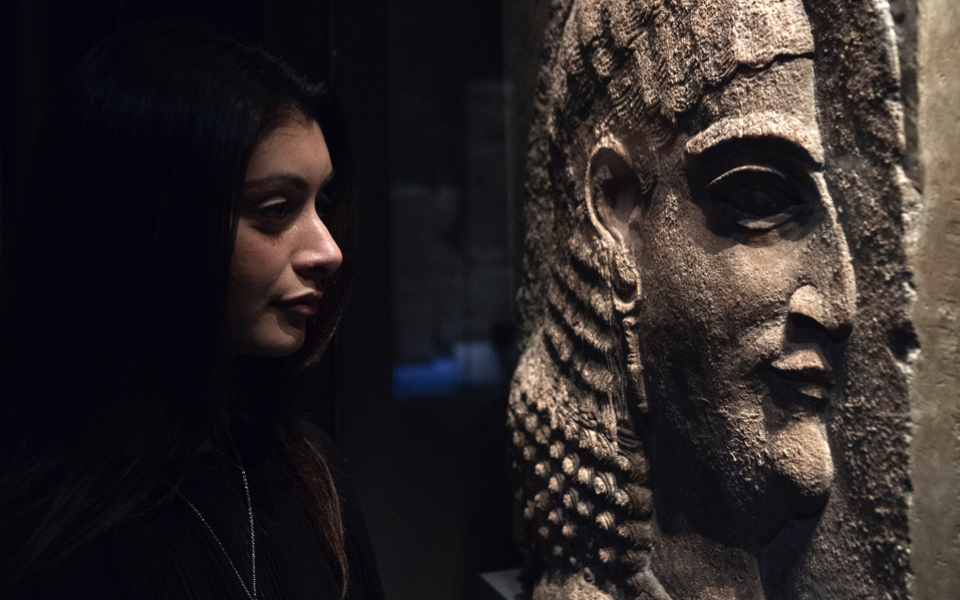Ashurbanipal, king of memory

Being in the presence of treasures that were hidden in the sands of Mesopotamia for more than 2,000 years until the mid-19th century, sculpted re-enactments of war and royal hunts, reading the words of kings, poets and chroniclers that were found in the palace library of Nineveh, is an unsettling experience. Until a few years ago, the combination of high art and horrific images, such as the beheading and skinning of prisoners, the attacks on unarmed civilians, the columns of slaves, would have been interesting in themselves as images of a strange and forgotten civilization – that of the Assyrians – from the height of its power in the 7th century BC. Today, they are a shocking reminder that humanity has not changed much. Those who are in power (and they need not be kings like the great Ashurbanipal of Assyria) arm themselves with similar means of control and terror: from the barbarians of the self-styled “Islamic State” who boast about cutting off heads and enslaving prisoners in the same deserts where the Assyrian armies marched, to the laboratories where new methods of surveillance and population control are developed.
“I am Ashurbanipal, great king, mighty king, king of the world, king of Assyria, king of the four quarters of the world,” declares the chronicle of the man who controlled the greatest empire of his age, from 669 BC to his death in around 631. Its territory included Egypt in the west, the mountains of western Iran in the east, the shores of the Persian Gulf in the south and the steppes of Central Anatolia in the north. Nineveh, on the Tigris River, with its massive walls and 18 gates was the greatest city in the world – famous to our day through references in the Bible and the historical chronicles of other nations.
The treasures on show at the British Museum’s grand exhibition, the statues, the sculpted reliefs displaying stories which the king wanted told, the thousands of cuneiform texts on clay tablets, part of the largest library of its era, constitute not only evidence of an important period but also a unique study on the projection of power. (The exhibition, “I am Ashurbanipal, King of the World, King of Assyria,” ends on Sunday, February 24.)
Ashurbanipal, third-born son of Esarhaddon, took over the kingdom when his father died unexpectedly while on a military campaign. Esarhaddon was the second son of Sennacherib, who was murdered by his first-born in 681 after passing him over. For Ashurbanipal to consolidate his reign he would face many dangers at court, especially the wrath of his elder brother, who had been appointed ruler of Babylonia, a subordinate role, by their father. (Sin-iddin-apli, the intended crown prince, died in 672 BC.) In 664, five years after Ashurbanipal came to power, the kingdom of Elam reneged on a treaty with Assyria. An Elamite named Teumman, who had played a leading role in earlier attacks on the Assyrians in Babylonia, seized power in Elam and found a pretext to declare war on Assyria. Ashurbanipal sent his army to deal with the threat and, after its victory, wrote about his triumph and depicted it in large reliefs that were set up in two of Nineveh’s palaces.
“Like the assault of a fierce storm, I covered the land Elam in its entirety. I cut off the head of Teumman, their presumptuous king who had plotted evil (deeds). I slew his warriors without number. I captured his fighting men alive. I filled the plains of the city Susa with their bodies like plants. I made the River Ulai flow with their blood; I dyed its water red like a red-dyed wool,” the Assyrian king declared in an inscription (quoted in the exhibition’s catalogue).
One of the panels depicts the two armies clashing, with many Elamites falling into the river and drowning. Teumman and his son find themselves flying off their chariot when it overturns; an arrow hits the king in the back and the two wage desperate battle, encircled by their foes; Assyrian soldiers behead the two and one carries the king’s head off in a chariot; finally, Ashurbanipal and his queen enjoy a quiet moment in their garden, while Teumman’s head hangs above them, on the branch of a tree. In other scenes, we see the battle, the harvest of heads, two men being flayed alive, defeated nations being deported or marching into slavery. The meaning is clear: Ashurbanipal creates and controls historical memory with pictures and texts; he also warns every potential foe what to expect.
The reliefs are sophisticated and expertly executed; the lion hunts, especially, as they capture the power of the beasts and their agony at the moment of their death. Many of these works had not been seen for 20 years, as the galleries that hosted them were closed. The current exhibition includes loans from the Louvre, the Cyprus Museum, the State Hermitage Museum in St Petersburg, Berlin’s State Museums and the Vatican.
Besides his power in war and the hunt – which is aimed at showing that the king is the paramount protector of his people – Ashurbanipal wanted to make clear that he possessed many other powers, too. He declares that he is educated, that he possesses much knowledge, including that of divination. He projects the image that knowledge is strength. Before ascending the throne, his father had placed him at the head of his intelligence-gathering network. Officers of the king could carry or relay messages across the empire with unprecedented speed, thanks to royal roads with way stations. In depictions of him, Ashurbanipal has a stylus tucked into his waistband, to show that he possesses the power of writing. He is proud that he is mighty without leading his troops into battle himself.
“I learned the craft of the sage Adapa, the secret (and) hidden lore of all the scribal arts. I am able to recognize celestial and terrestrial omens… I can resolve complex (mathematical) divisions (and) multiplications that do not have an (easy) solution. I have read cunningly written texts in obscure Sumerian (and) Akkadian that are difficult to interpret. I have carefully examined inscriptions on stone from before the Deluge that are sealed, stopped up, (and) confused,” Ashurbanipal wrote.
The “king of the world” wanted to control the present and memory. But, after his death, in circumstances unknown to us, we learn something else, something that the “Islamic State,” too, found out: When you are so dangerous, you will inspire many to join forces against you. In 626 BC, a general called Nabopolassar seized the throne of Babylon and sparked a rebellion across the empire. In 612, an alliance of Babylonians, Medes, Persian, Scythians and Cimmerians burned Nineveh, the world’s greatest city, to the ground.
The memories of Ashurbanipal and his power, his threats, his achievements, his empire’s treasures and its great store of written knowledge, all disappeared. Until archaeological excavations began in the 1840s.




